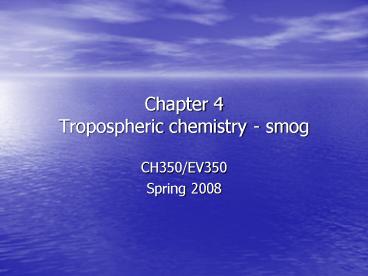Chapter 4 Tropospheric chemistry smog - PowerPoint PPT Presentation
1 / 20
Title:
Chapter 4 Tropospheric chemistry smog
Description:
Photochemical Made famous in Los Angeles. Elevated levels of ... 'Air pollution comes from trees' Ronald Regan early 1980s 5. 50-250. PANs 5. 50-150 ... – PowerPoint PPT presentation
Number of Views:327
Avg rating:3.0/5.0
Title: Chapter 4 Tropospheric chemistry smog
1
Chapter 4Tropospheric chemistry - smog
- CH350/EV350
- Spring 2008
2
Smog
- Smoke Fog
- Classical
- Unburned carbon soot from coal
- SO2
- Reducing and acidic
3
Smog
- Photochemical Made famous in Los Angeles
- Elevated levels of oxidants and carbon rxn
products - Thermal reactions favored in warm weather
- Photochemical reactions favored during the day
- Atmospheric inversion is necessary to keep the
pollution in place where it reacts
4
Chemical Compositions of smog events
- NO and hydrocarbons start to build around 600 AM
- NO drops leading to NO2
- NO2 and hydrocarbons drop around 900 AM and lead
to aldehydes and oxidants - Everything returns to normal at 800 PM
5
Smog Chemistry NOx chemistry
- Internal combustion engines generate NO
- NO is converted to NO2
- NO2 generates ground state O atoms
- O atoms react to form O3
N2 O2 heat ? 2NO 2NO O2 ? 2NO2 NO O3 ?
NO2 O2 ROO. NO ? RO. NO2 NO2 hn
(llt400nm) ? NO O O O2 M ? O3
6
Smog Chemistry - .OH production
- O3 then undergoes photolysis generating excited
atomic oxygen (O) - O reacts with water to form hydroxyl radicals
(.OH) - Higher humidity causes more .OH
- HONO chemistry is important in heavily polluted
atmospheres
O3 hn (llt315nm) ? O2 O O H2O ? 2.OH NO
NO2 H2O ? HONO 2HONO hn (llt400nm) ? 2NO
2.OH
7
Smog Chemistry Oxidation of hydrocarbons
- .OH reacts with hydrocarbons to form
- Carbon centered radicals
- Alkyl peroxides
- Aldehydes (RCHO)
- They hydroxyl radical is regenerated after
reaction with NO
.OH RCH3 ? .RCH2 H2O .RCH2 O2 M ? RCH2OO.
M RCH2OO. NO ? NO2 RCH2O. RCH2O. O2 ?
RCHO .OOH .OOH NO ? NO2 .OH NET RCH3 2O2
2NO ? RCHO 2NO2 H2O
8
Smog Chemistry Radical termination
- .OH reacts NO2 forming nitric acid
- Oxygen radicals terminate at hydrogen peroxide or
water
.OH .NO2 ? HNO3 2HOO. ? H2O2 .OH HOO. ? H2O
O2
9
Smog Chemistry PAN formation
- .OH reacts with aldehydes to form acetylperoxy
(CH3C(O)OO.) radicals and peroxyacetic nitric
anhydride (PAN) - PAN are major eye irritants
- PAN is a nitrogen reservoir species
.OH CH3CHO ? CH3CO. H2O CH3CO. O2 M ?
CH3C(O)OO. (acetylperoxy) CH3C(O)OO. .NO2 ?
CH3C(O)OONO2 (PAN)
10
(No Transcript)
11
Concentrations of pollutants in a smog event
- Hydrocarbons in cities often come from fuel
sources, either unburned fuel or vaporizaiton of
fuel - Hydrocarbons, like terpenes, in rural areas come
from trees. - Air pollution comes from trees Ronald Regan
early 1980s
12
Comparison of emissions from internal combustion
engines
- Four-stroke engines most car and pickup truck
engines, riding lawn mowers - Two-stroke engines many push lawn mowers, chain
saws - Diesel engines large equipment, most tractors,
some cars and pickup trucks
13
Four-stroke engine
- http//auto.howstuffworks.com/engine1.htm
14
Four-stroke engine
- Fuel/air ratio important
- Lean fuel
- Low VOC emissions
- High NO emissions due to higher operating
temperature - Rich fuel
- High VOC emissions due to unburned fuel
exhausting to atmosphere - Lower NO emissions due to lower operating
temperature
15
Reduce VOC and NOx emissions from four-stroke
engines
- Add oxygenates to fuel causes cleaner burning
less unburned hydrocarbons in exhaust - Ethanol common now
- MTBE was common
- Use catalytic converters
2NO 2CO Rh catalyst ? N2 2CO2 RH O2 Pd
or Pt catalyst ? CO2 H2O 2CO O2 Pd or Pt
catalyst ? CO2
16
Two-stroke engine
- http//science.howstuffworks.com/two-stroke2.htm
17
Two-stroke engine
- Unburned hydrocarbons leaving exhaust
- Some unburned fuel pushes out exhaust
- Oil used to lubricate doesnt burn very well
- Lower operating temperature than four-stroke
engines causes less NOx emissions
18
Two-stroke and four-stroke exhaust gas output
(10-8 g/J)
- Two-stroke
- More VOC
- Less NOx
- Four-stroke
- Very low VOC
- Somewhat more NOx
19
Diesel engine
- http//auto.howstuffworks.com/diesel1.htm
- Higher compression ratios than four-stroke
gasoline engines - Causes larger pressures and temperatures
- Spontaneous ignition of fuel
- Not always good mixing of air and fuel
- Soot production
- High combustion temperature causes NOx emissions
20
Controlling O3
- Ozone production based on NOx and VOC
- Which is limiting reagent?
- Assume polluted city with high VOC (point A)
- NOx is limiting reagent
- Lowering VOC to point B will not lower O3 very
much - Lowering NOx to point C could dramatically lower
O3






























